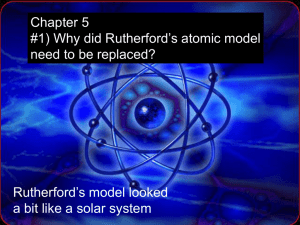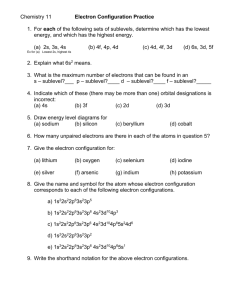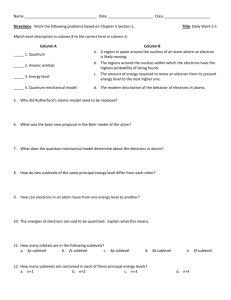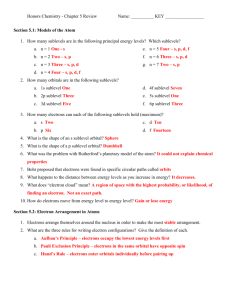Chapter 5 Review
advertisement
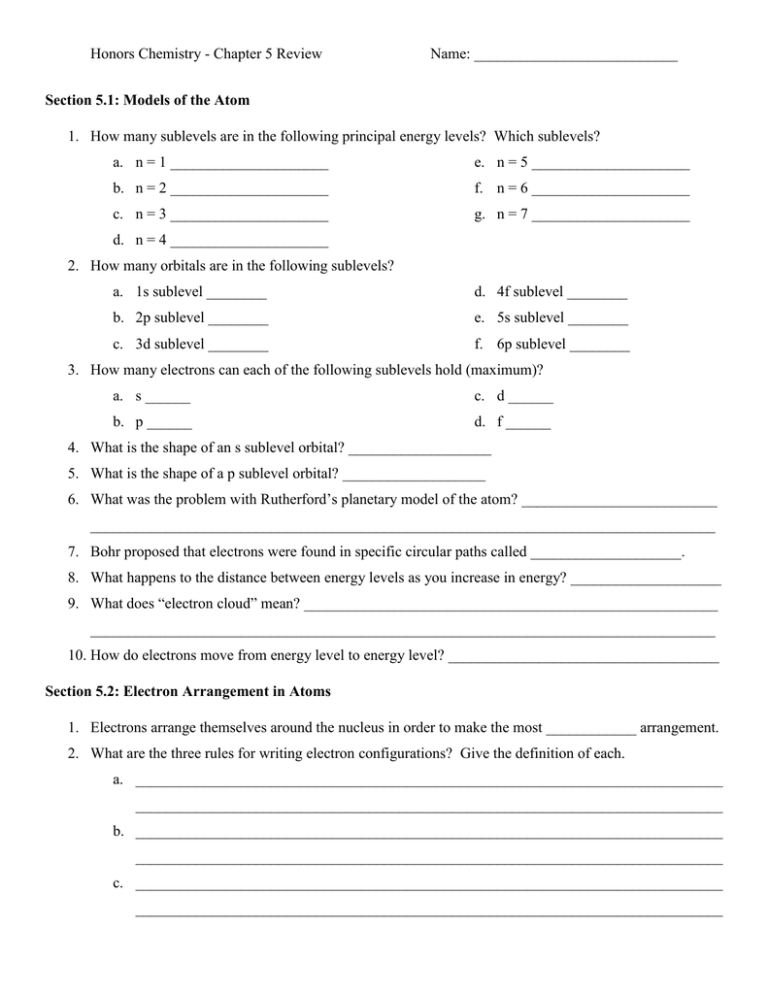
Honors Chemistry - Chapter 5 Review Name: ___________________________ Section 5.1: Models of the Atom 1. How many sublevels are in the following principal energy levels? Which sublevels? a. n = 1 _____________________ e. n = 5 _____________________ b. n = 2 _____________________ f. n = 6 _____________________ c. n = 3 _____________________ g. n = 7 _____________________ d. n = 4 _____________________ 2. How many orbitals are in the following sublevels? a. 1s sublevel ________ d. 4f sublevel ________ b. 2p sublevel ________ e. 5s sublevel ________ c. 3d sublevel ________ f. 6p sublevel ________ 3. How many electrons can each of the following sublevels hold (maximum)? a. s ______ c. d ______ b. p ______ d. f ______ 4. What is the shape of an s sublevel orbital? ___________________ 5. What is the shape of a p sublevel orbital? ___________________ 6. What was the problem with Rutherford’s planetary model of the atom? __________________________ ___________________________________________________________________________________ 7. Bohr proposed that electrons were found in specific circular paths called ____________________. 8. What happens to the distance between energy levels as you increase in energy? ____________________ 9. What does “electron cloud” mean? _______________________________________________________ ___________________________________________________________________________________ 10. How do electrons move from energy level to energy level? ____________________________________ Section 5.2: Electron Arrangement in Atoms 1. Electrons arrange themselves around the nucleus in order to make the most ____________ arrangement. 2. What are the three rules for writing electron configurations? Give the definition of each. a. ______________________________________________________________________________ ______________________________________________________________________________ b. ______________________________________________________________________________ ______________________________________________________________________________ c. ______________________________________________________________________________ ______________________________________________________________________________ Honors Chemistry - Chapter 5 Review Name: ___________________________ 3. Write the complete electron configuration for each of the following elements: a. Hydrogen __________________ b. Vanadium ___________________________________________________________ c. Magnesium __________________________________________________________ d. Cesium ____________________________________________________________________ e. Arsenic ______________________________________________________________ 4. Write the abbreviated electron configuration for each of the following elements: a. Cesium __________________________________________________ b. Lithium __________________________________________________ c. Aluminum __________________________________________________ d. Silver __________________________________________________ e. Gallium __________________________________________________ 5. Identify the elements below based on their electron configurations: a. 1s22s22p63s23p5 _____________________________ b. 1s22s22p5 _____________________________ c. 1s22s22p63s23p64s23d104p65s24d105p5 _____________________________ 6. Which elements are exceptions to the Aufbau Principle (Name 2): ______________________________ 7. Explain why the actual electron configurations for some elements differ from those assigned using the Aufbau principle. _____________________________________________________________________ ____________________________________________________________________________________ 8. True or False: The configuration 4s23d4 is more stable than the configuration 4s13d5. _____________ Honors Chemistry - Chapter 5 Review Section 5.3: Physics and the Quantum Mechanical Model Name: ___________________________ 1. What is the frequency of radiation with a wavelength of 5.00 x 1015 m? 2. What is the energy of a photon with a frequency of 2.22 x 1014? 3. Suppose your favorite radio station broadcasts at a frequency of 1600 Hz. What is the wavelength of the radiation? 4. Arrange the following types of electromagnetic radiation in order of increasing frequency based on the chart below: a. Infrared d. Radio waves b. Gamma rays e. Microwaves c. Visible light f. Ultraviolet 5. Label the parts of the wave (4 parts): Honors Chemistry - Chapter 5 Review Name: ___________________________ 6. What is the relationship between wavelength and frequency? What does this mean? ____________________________________________________________________________________ ____________________________________________________________________________________ 7. Einstein proposed that light is composed of particle-like quanta of energy known as _______________. 8. True or False: Heisenburg stated that the position and velocity of subatomic particles can be determined with certainty. _____________
